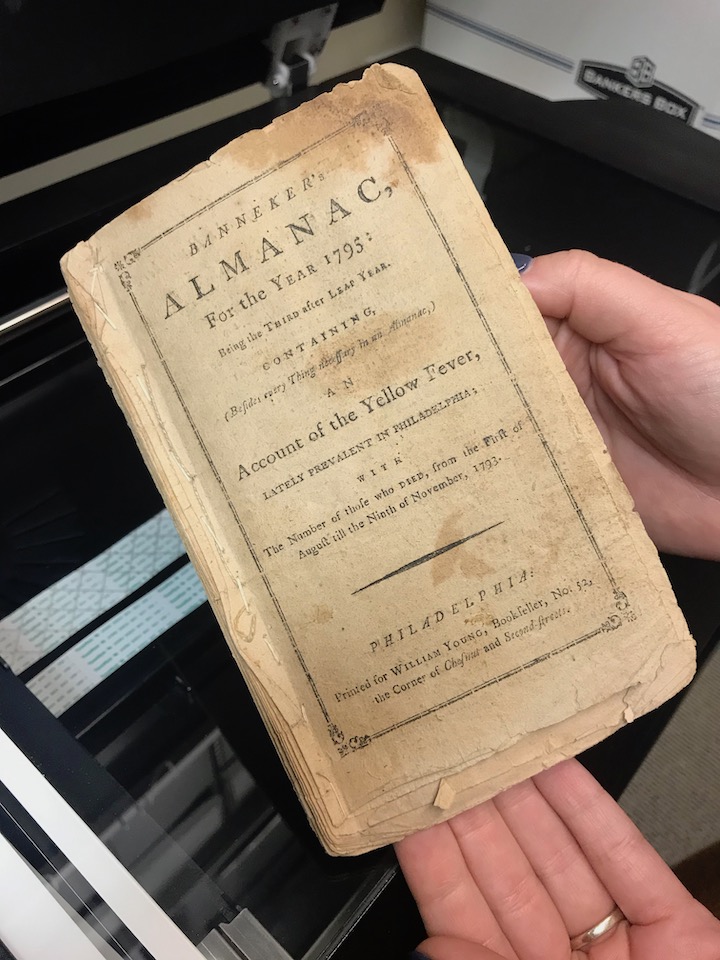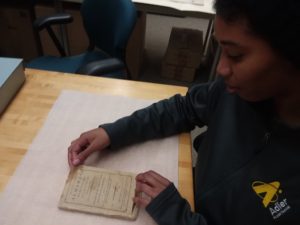Banneker: An Immortal Legacy

Header Image: Benjamin Banneker’s almanac for the year 1795 being digitally scanned for preservation.
BENJAMIN BANNEKER’S 1795 ALMANAC
Way before we had smartphones, almanacs were an important source of practical information and amusement for many people. African-American astronomer and mathematician Benjamin Banneker (1731-1806), produced several almanacs, which were published over a period of six consecutive years until 1797. Banneker’s almanacs proved very successful, selling in great numbers and totaling at least 29 editions. These were small, affordable, and fragile booklets for popular consumption, and most of the many copies that were printed and sold likely perished. We are lucky to have a well-preserved copy of the Philadelphia edition of Banneker’s almanac for 1795 in our collections.
Benjamin Banneker was so revered for his knowledge of astronomy, mathematics, and scientific instruments that in 1791 he was asked to help produce the first ever survey map of the District of Columbia—the lands in Maryland and Virginia that had been set aside to establish a national capital.
The 1795 almanac in our collections will be brought out for public viewing on February 17th in the Adler Planetarium’s Space Visualization Lab and at the February 20th event, Adler After Dark: A Night In The Afrofuture 2.0. Jasmine Porter, one of our Guest Services Representatives, recently got to view the almanac up close with The Adler Planetarium’s Collections team.
I distinctly remember a 15-year-old me laying on my Mother’s couch watching an episode of The Universe.
Seeing Neil deGrasse Tyson for the nth time resurfaced a nagging query that had visited me earlier that day, a query that refused to sink back into my subconscious—not even for the rest of the episode. I took one more good look at Tyson and thought, “I love ya Neil, but you can’t be the only one.”
I reached for my BlackBerry Bold and probed the web for Black astronomers. Google swiftly introduced me to Benjamin Banneker. I spent the next few hours learning about the crops he grew, the almanacs he wrote, our capital he co-surveyed, the clocks he made, the stars he gazed, the numbers he crunched… the fight he fought.
“Sheesh,” I thought, “What didn’t you do?”
Fast forward a whole decade, I’ve never forgotten Benjamin Banneker. Recently, I name-dropped him at a planning meeting for Black History Month here at the Adler. As luck would have it, our Collections team had recently discovered that we owned an original copy of one of his surviving published works. Our Curator, Pedro Raposo, kindly invited me to the Adler’s Collections Department to have a look at this masterpiece, along with some other Banneker-related items.
Before I knew it, the pocket-sized piece of history called Banneker’s Almanac, for the year 1795 lay right in front of me. Bronzed and crinkled by time, the 18 string-bound pages of Benjamin’s effort, energy, and insight were at my fingertips just waiting to be sifted through.

Its pages bore a wide range of subject matter. An astrology-infused body diagram, chartings of predicted celestial alignments and eclipses for the year, an account of the Yellow Fever epidemic in Philadelphia, and even a long list of currency conversions; all of them finely detailed and tediously calculated.
Spending time with this almanac in person was a more profound experience for me than standing in the Assembly Room of Independence Hall (which I had done not long after my initial discovery of Banneker ten years ago).
In his life, Banneker fought against chattel slavery. He lived, learned, and worked at the height of the transatlantic slave trade as a person of African origin in what would become the United States of America. In Benjamin’s lifetime, this meant that your perceived and delegated status in this country was that of property. Just eight years before this almanac was published, the Three-Fifths Compromise was added to the U.S. Constitution, which decreed that enslaved Africans were to be considered only three-fifths of a human being.
Individuals like Benjamin Banneker need to be celebrated more. To see and touch a product of someone who ardently fought to dismantle slavery and push our country to truly live up to its reputation as the “land of the free” was an incredible honor.






